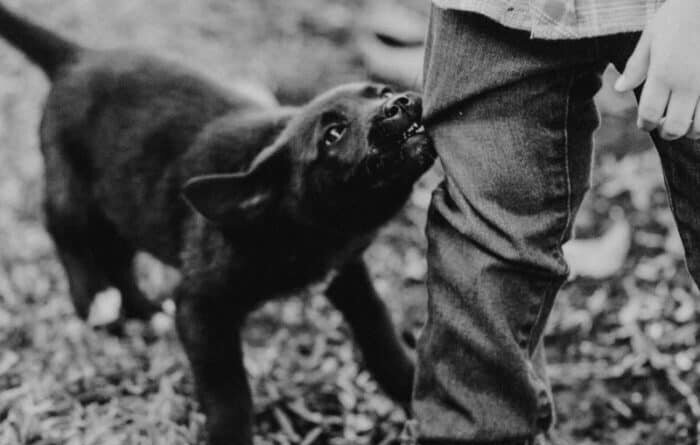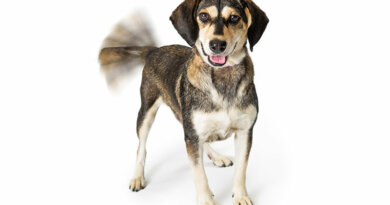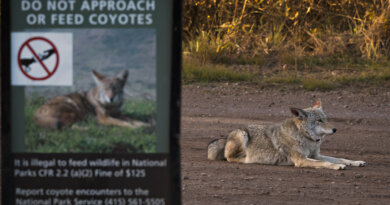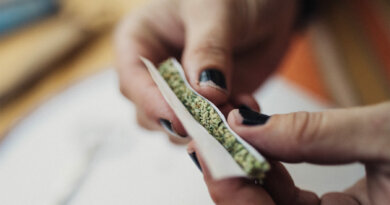How To Stop a Puppy From Tugging on Clothing
This post may contain affiliate links. We may earn money or products from the companies mentioned in this post.
You envisioned that your new puppy, Max, would walk calmly next to you in heel position.
But then reality hits when he’s pulling on your pants leg: you’ve become his tug toy.
So you wonder what you should do to preserve your wardrobe and how to stop a puppy from tugging on clothing.
In this article, I’ll explain why puppies tug on clothing. And I’ll set forth what you should do to prevent this problem and to correct it when it does occur.
Why Puppies Tug on Clothing
Puppies explore the world with their mouths. Anything is fair game.
Pulling on our clothing is very enticing to them and fun. And it may be cute in the beginning.
But I’m sure that you don’t want to buy a new wardrobe or wear “dog-eared” (pun intended) clothes.
And, as a puppy grows stronger and has adult teeth, this behavior can become dangerous.
It can turn into biting as he gets his adult teeth. And he may even knock or pull someone down when he tugs.
So it’s important to understand why your puppy is tugging on your clothes in order to know how to stop it.
The following are some reasons why your puppy may be pulling on your clothes:
1. Your puppy may be teething
Teething puppies try to soothe their sore gums by chewing on whatever’s available. They are little land sharks with needle-like teeth.
So the cloth on your new jeans is fair game as far as your puppy is concerned.
If you’re sitting down next to him, your sweater, shirt, and even nearby pillows are soft and he will probably try chewing on them too.
2. Your puppy may have too much energy
I’m sure that you’ve seen your puppy not behave well when you don’t have time to exercise him. Or when the weather’s bad and he doesn’t get his daily walks.
When your puppy has too much energy to spare, he will inevitably engage in behaviors you don’t want.
He may chew on the furniture, have potty accidents, and even see you as a living chew toy and tug on your clothing.
3. Your puppy may be overly tired
Just like a fatigued toddler, a puppy may “act out” when he’s too tired. And he will probably pull on your clothes.
4. Your puppy may be bored
Your puppy may just be looking for something to do. Unfortunately, you and your clothes can be what he literally latches onto.
5. The tugging on your clothing may occur because of your puppy’s genetic make-up
A herding breed or mix may be trying to herd you when he nips at your shoes and clothes. Shelties, Aussies, and corgis will engage in these behaviors.
They want to control your motion just as they would a flock of sheep. This is especially true when someone walks by quickly or noisily.
So, if you’re running or if the children are screaming and running as they play, a herding dog may attempt to drive everyone where he thinks that they should be.
When my many shelties were puppies, they would try to grab the bottom of my pants leg and tug.
I have to admit that it’s cute the first time, but I knew the consequences of not stopping the tugging.
So I worked with the issue using some of the techniques I describe below.
And, happily, I’ve been able to walk around without a dog latching onto me.
A retriever sometimes has a need to have something in his mouth.
And that something could be the clothes you wear if nothing else is handy.
My rescued golden retriever Spencer always had to have something in his mouth.
So, instead of it being the shirt on my arm or my pant leg, I made sure that he had an assortment of toys he liked to carry around with him.
Dogs with a high prey drive such as terriers may also tug your clothes–especially if you’re moving quickly.
6. Your puppy may want to play
It may be as simple as your puppy needs to play.
Puppies are usually very playful and will grab whatever–or whoever–is nearby.
Play biting is a common puppy behavior. So the pup turns tugging on our clothing into a fun (for him) game.
7. Your puppy may want attention
You may be busy working on your computer. All of a sudden, you feel a tug on your clothes.
It’s your pup reminding you that he’s there–and wants your attention.
8. Your puppy may be exploring the environment
Of course a puppy can’t really grab items with his feet. He doesn’t have opposable thumbs.
So he explores the world with his mouth. And your clothing is easy to reach.
9. Your puppy may be overstimulated by the environment
Some puppies will grab whatever they can when they’re excited.
So if there’s a lot of noise and excitement such as children running and playing or people dancing, a puppy will naturally latch onto the nearby clothing he sees.
This can also occur while on walks, where a puppy may see many things that excite him such as squirrels, dogs passing by, or someone mowing the lawn.
You’re next to him and he may grab your clothes in his excitement.
10. You may have unintentionally encouraged him to tug on clothes
You may have inadvertently rewarded the behavior.
You could have been excited when he tugs, or tugged back making him think it’s a game that you’re enjoying.
11. Your puppy may have the zoomies
Sometimes puppies tug our clothing because they need to release energy.
Usually, they’ll start to run around in a crazy pattern and grab whatever’s convenient.
What You Should Do To Prevent or Correct Tugging on Clothing
There are measures you can take to help prevent a puppy from grabbing your clothes. And you can also use certain methods to break the pattern.
You’ll probably have to use more than one of the following techniques in order to get your puppy to stop tugging on your clothes.
Play biting is a normal puppy behavior. Luckily, most puppies outgrow it. But, in the meantime, you need to work through the issue.
1. End the interaction when your puppy tugs on your clothes
Imagine that you’re playing with your puppy and he starts grabbing the edge of your sweater’s sleeve or the leg of your pants.
He starts ferociously tugging with all his might instead of grabbing the rope toy in your hand.
End the playtime whenever your puppy’s teeth touch your skin or clothing.
Freeze in place and don’t make eye contact with your pup.
Stand up tall when his teeth aren’t on you and hold still.
Fold your arms in front of you so that he can’t grab them.
Be consistent and make sure that you don’t play his game.
This often works because the puppy isn’t getting the attention that he craves. Afterward, redirect him to another activity or obedience cue.
But some puppies won’t give up the tugging.
Then, use some of the other techniques below.
2. Make sure that your puppy has enough physical and mental exercise
The amount of physical exercise your puppy needs for his physical and mental well-being will vary depending on his age and breed(s).
If you’re in doubt regarding his needs, check with your vet.
Generally, working, herding, and sporting breeds and terriers require more exercise than toy breeds do.
And young puppies often require more naps than older puppies and adult dogs do.
But there’s more to it than just physical exercise. You also need to exercise your puppy’s mind.
So have puzzle toys ready. A flirt pole can exercise and redirect your pup to another activity.
And teach your puppy obedience commands and tricks.
Socialization to new experiences, people, and friendly dogs also helps broaden your puppy’s horizons–and will help tire him out.
3. Schedule playtime, walks, down time, and nap times
This seems like it’s obvious. But, in our busy lives, sometimes a puppy’s needs get lost in the shuffle.
So if for some reason you aren’t able to walk your dog or play with him on a certain day, have a trusted friend, family member, or dog walker meet your pup’s needs.
4. Teach obedience commands
Certain training cues are especially important to help stop a puppy from tugging at your clothes.
Of course, teach your puppy to pay attention and look up at your face when you say his name. You can also teach him an attention cue like “look.”
If he’s paying attention to you, he won’t be tugging on your clothes.
Also teach your puppy the “leave it” command.
Then, you can tell him to leave anything and not pick it up or put it in his mouth–including you and your clothing.
This can also save a dog’s life because he may attempt to grab something that can be harmful.
Pups should also learn “drop it” and “give” cues.
I use “drop it” to teach a puppy to drop something to the ground and “give” to release what’s in his mouth to my hand.
Also teach a “touch” cue where your puppy learns to gently touch his nose to the palm of your hand.
Teach your puppy to heel alongside you.
This means that he’s paying attention to you and his position next to you rather than your clothes.
Of course your puppy should also learn to come to you and sit and lay down on cue.
5. Teach impulse control exercises
The more that your puppy can control his own behaviors, all of his actions will be better regulated.
Teach your puppy a “settle” command that you can use before he starts to grab your clothes.
Teach him to go a place and settle there.
This can be a dog bed that’s kept in the same place in a room.
Of course a very young puppy will find this exercise to be difficult if he doesn’t yet perform a solid sit/down/stay.
But by the time a pup reaches five or six months old, he should be able to sit and down on your verbal cue and hand signal.
Teach a “zen” exercise. This training lesson teaches a puppy to control his natural impulses and drives.
Place a small treat in your hand, palm up, and close your fist. Have another reward treat ready in your other hand.
Place your closed fist with the treat right in front of your puppy’s nose. If your pup mouths or paws at your hand, ignore it.
The second that he’s calm without interacting with your closed fist, mark the behavior with “yes” and give him the treat from the other hand.
Do this exercise a few times. End on a successful note.
Most puppies start to understand that when they engage in behaviors we don’t want such as mouthing or pawing at the closed fist with the treat, they don’t get any reward.
What if your puppy doesn’t stop mouthing or pawing at your closed fist?
Put your fist behind your back and walk away.
Next time you train him, set him up to succeed. Make sure that he’s had enough exercise prior to the training session.
6. Capture and reward desired behaviors
When your puppy’s calm, praise (“good settle”) and reward.
You can give a small tidbit of a treat. Or you can give him a safe chew or frozen stuffed Kong so that he will remain lying down and calm.
Licking the stuffing out of a Kong is actually calming to a dog.
7. Use an interrupter
This can help teach your puppy to remove his teeth from your clothes. But it shouldn’t be the only way you teach him that tugging on your clothes is unacceptable.
You can say something like “hey” and, the second that your pup removes his teeth, reward him with a toy and game of fetch.
Or, if he knows how to sit on cue, have him sit, then release him and reward with a favorite toy.
Just note that some puppies may be overstimulated even by saying “hey.” Of course this training exercise should be avoided then in the future.
8. Redirect to an acceptable activity
Before your adorable little piranha’s teeth reach your clothes, redirect him to something else to do.
Have a favorite toy of his ready and have him fetch it.
Or have a safe chew or stuffed frozen Kong ready. Have him perform an obedience cue such as “sit,” then give it to him to occupy him and his mouth.
9. Give him a nap
If your puppy is overly tired, he may act out much as a small toddler would. So what he needs is a nap.
Just be sure that his crate doesn’t become something negative to him.
So you can first have him perform an obedience cue and reward him.
Then have him enter his crate with a safe reward such as an appropriately-sized stuffed frozen Kong.
10. Give your puppy a time-out
Sometimes when a puppy is overstimulated, he needs a place to chill out.
Of course you don’t ever want his crate to be a punishment.
So when I give a puppy a short (10-minute maximum) time-out, I use a different, safe, puppy-proofed area. It can be a laundry room or bathroom.
Or you can even teach your puppy (observed, of course so that he can’t strangle himself) to be on a tether nearby.
As long as your puppy doesn’t chew it, you can use a six-foot leash tied to an immovable piece of furniture.
When I’ve used this method (which was very infrequently), I would lead the puppy to the place and say “time out,” then walk calmly away.
If this method is to work, you must just leave the puppy for a short time until he calms down (minutes at most).
Then, release him from the place and have him perform an obedience cue or redirect him to an acceptable game.
11. Manage your puppy’s environment
Don’t have your puppy go over his threshold.
If you have some things in your puppy’s environment that are too over-stimulating, change his environment until he’s able to handle it.
Puppies and children can be a great combination. But all interactions should be monitored and directed.
So if he runs after toddlers, tugging on their clothes and pulling them down, while they’re running and playing, don’t have your puppy there until the children settle.
And teach your puppy to ignore such distractions and redirect him to other acceptable activities.
But also instruct children (and rambunctious adults) to be calm around the pup. No rough-housing or wrestling with the pup.
Make sure that clothing items–including laundry–are kept out of your pup’s reach as much as possible.
Clothing, especially those with our scent, are very inviting to most puppies.
12. Place a chew deterrent on your clothes
If your puppy goes after the bottom of your pants leg, you can spray a chew deterrent such as Bitter Yuck there before your pup approaches. Don’t spray it at or near your puppy.
Of course you don’t want to ruin your new Levis. So do this with an old pair of pants that you don’t care about anymore.
You can then spray the bottoms with Bitter Yuck immediately prior to wearing them.
13. Use calming aids
If you need additional help calming your puppy down, there are many things that you can use.
You can get your puppy used to wearing a ThunderShirt. Or use Adaptil, which mimics the pheromones of the puppy’s mother. It comes in a plug-in, collar, and spray.
There’s even music made to calm dogs called Through a Dog’s Ear that helps calm dogs down.
14. Get professional help if needed
If all else fails, get professional help if you need it.
A positive reinforcement trainer who has experience with puppy behaviors can set you and your puppy on the right track. And save your wardrobe.
What NOT To Do: Don’t Try This at Home
There are many actions that you shouldn’t take in attempting to solve the problem of your puppy tugging on your clothes.
1. Don’t overstimulate your puppy
Part of having a puppy is playing with them and having fun. But you don’t want to become his chew toy.
So don’t wave your arms around as if you’re a toy. Be fun but don’t act like you’re the game.
2. Don’t unintentionally reward his tugging on clothes
You shouldn’t tug back or your puppy will think that you’re having fun with–and rewarding him for–a game.
I know that this is easier said than done. But try the above-listed methods instead.
3. Don’t physically correct your puppy
Grabbing a puppy’s muzzle or otherwise physically correcting him won’t work. And they can be abusive.
So don’t push him off or hit him.
Also, don’t otherwise intimidate him by spraying him with water or shaking a can of pennies at him.
Doing so may even teach him to fear you and become hand shy. And he may even become aggressive when you attempt to handle him.
4. Don’t scream at your puppy
Using an interrupter such as “hey,” as described above can work if you redirect your puppy to an acceptable activity as soon as he removes his teeth from your clothing.
But, if you get too excited and scream at him, your puppy will probably become over-stimulated and his behavior of yanking on your clothes will escalate.
Or some puppies will even become afraid of you.
In either case, you won’t achieve the result that you desire. And you may even create other behavior problems.
5. Don’t rough house
Make sure that no one who engages with your puppy rough houses with him.
This includes no wrestling games or waving arms round. And no tug of war for now.
I play tug of war only with dogs who understand to take a toy on cue (“take it”) and release it on cue (“give”).
6. Don’t play with your dog using clothing or similar items
Years ago, many people used old socks or towels as toys for their dogs.
But this only teaches your puppy to believe that they’re fair game. So use other safe toys made for dogs instead.
FAQs
My puppy tugs on my clothes and has already ruined a few pairs of pants. Should I push him away?
No! Doing so probably won’t work and can even lead to hand shyness or aggression. Instead, make sure that he’s had enough physical and mental exercise.
And teach him obedience commands such as paying attention, leave it, sit, heel, and down.
And have something ready such as a favorite to or chew to redirect him before his teeth are on your clothes.
My family gives my puppy old socks as toys and now he always wants to pull the socks off my feet. What should I do?
First of all, stop giving your puppy clothing as toys. A pup can’t differentiate between old socks and new. Instead, have safe toys and chews available for him to play with.
My puppy gets very excited when my two toddlers are playing. He grabs their clothes and pulls them over, which scares them. And he gets even more excited when they cry. What should I do?
Never leave your puppy alone with your children. Accidents can happen.
Have them interact only when supervised and after your puppy has a sufficient amount of exercise for his age and breed.
Teach your toddlers to be calm around your puppy. Reward them for being calm. Positive reinforcement works for people too!
And teach your puppy obedience commands and impulse control exercises.
Final Thoughts
Puppies explore the world with their mouths. There are many reasons why they love to tug at our clothes.
It’s up to you to be a detective and discover the reasons your puppy does. Then you can take the measures necessary to avoid and correct that behavior.
Have you had a puppy who tugs on your clothes?
What have you done about it? Did it work?
Please tell us about it in the comments section below.
Save To Pinterest
Top Picks For Our Puppies
- BEST PUPPY TOY
We Like: Calmeroos Puppy Toy w/ Heartbeat and Heat Packs – Perfect for new puppies. Helps ease anxiety in their new home. - BEST DOG CHEW
We Like: Bones & Chews Bully Sticks – All of our puppies love to bite, nip, and chew. We love using Bully Sticks to help divert these unwanted behaviors. - BEST DOG TREATS
We Like: Crazy Dog Train-Me Treats – We use these as our high-value treats for our guide dog puppies. - BEST FRESH DOG FOOD
We Like: The Farmer’s Dog – A couple months ago we started feeding Raven fresh dog food and she loves it! Get 50% off your first order of The Farmer’s Dog.
Check out more of our favorites on our New Puppy Checklist.




